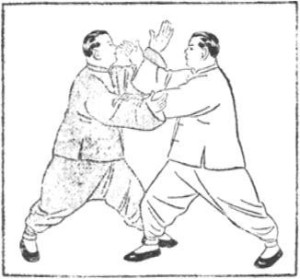For use in fighting, Taijiquan specializes in from-contact striking and stand-up grappling. While maintaining our own stability (central equilibrium), we try to disrupt our opponent’s stability, while in the middle range, to create openings for strikes, throws, locks, and other attacks. These attacks can be applied any time there is an opening but, due to our control of the contact prior to the attack, we prefer to strike when the opponent is unstable and less able to defend against the technique; to throw when they are already losing their balance and unable to counter or to drag us down to the ground with them; to create other weaknesses that we can exploit that make it difficult for the opponent to defend against our attack.
Taijiquan fighting can be divided into three steps, neutralize (hua 化) the opponent’s attack, seize (na 拿) or gain control creating an opening, and strike (da 打) or attack. Whereas push-hands trains defense (hua) and the off-balancing (na) that sets up attacks, the actual attacking techniques (da) are more commonly taught as individual applications from the solo form(s). Some Yang style schools also have a two-person choreographed sparring set that teaches hua, na and da.
 Taijiquan’s push-hands training can be used as a safe method for learning and improving ones understanding of the principles that underlie this art. It is not fighting, although it trains principles that may be applied to fighting. There are many skills that can be trained using push-hands that are useful for situations other than fighting, but to use Taijiquan for fighting, I feel that push-hands training alone is insufficient, though push-hands may be necessary in order to train qualities that are desirable for fighting using Taijiquan strategies and principles.
Taijiquan’s push-hands training can be used as a safe method for learning and improving ones understanding of the principles that underlie this art. It is not fighting, although it trains principles that may be applied to fighting. There are many skills that can be trained using push-hands that are useful for situations other than fighting, but to use Taijiquan for fighting, I feel that push-hands training alone is insufficient, though push-hands may be necessary in order to train qualities that are desirable for fighting using Taijiquan strategies and principles.
In solo form, some of these principles are taught, but without testing in an interactive environment it is sometimes difficult to know if one really understands and embodies the principles. There are also numerous principles that cannot be trained solo.
Push-hands skills involve connecting with incoming energy or force, and understanding it and controlling it without directly opposing it. It is an alternative approach to the typical “fight-or-flight” response to conflict.
Taijiquan theory is based on the taiji diagram (taijitu 太極圖), which illustrates the changing dynamics of the interactions of yin (阴) and yang (阳) energy. Practitioners train to harmonize yin and yang energy during interactions such that one does not overemphasize yang (e.g. fight, tense, push, expansion, advance) or yin (e.g. flight, limp, pull, contraction, retreat) but maintain a taiji balance.
Taijiquan is the art of maintaining the balance of taiji (yin & yang) throughout the changes encountered during solo and partner training (as well as during everyday activities). Push-hands provides a training format where you attempt to maintain your balance of taiji even when challenged by your partner; and you learn to sense and create imbalances in your partner so that you can control them by taking advantage of their excesses or deficiencies in yin and yang energies.
To summarize, Taijiquan push-hands is used to train the skills necessary to control the middle range. To fight with Taijiquan skills requires one to learn how to go from non-contact (long range) to the middle range without allowing the opponent to escape back to non-contact range, as well as preventing the opponent from closing to grappling (close) range or taking the conflict to the ground. A Taijiquan practitioner seeks to attack from middle range before the opponent can escape back to long range and before they can close to short range. Control of the middle range provides defense by neutralizing the opponent’s attacks as well as disrupting the stability of the opponent. It also produces the openings and opportunities to attack with from-contact strikes and using stand-up grappling techniques.

Leave a Reply